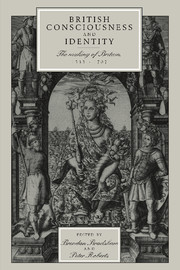Book contents
- Frontmatter
- Contents
- Notes on the contributors
- Preface
- Introduction
- 1 Tudor Wales, national identity and the British inheritance
- 2 The English Reformation and identity formation in Ireland and Wales
- 3 Faith, culture and sovereignty: Irish nationality and its development, 1558–1625
- 4 From English to British literature: John Lyly's Euphues and Edmund Spenser's The Faerie Queen
- 5 The British problem in three tracts on Ireland by Spenser, Bacon and Milton
- 6 James Ussher and the creation of an Irish protestant identity
- 7 Seventeenth-century Wales: definition and identity
- 8 Scottish identity in the seventeenth century
- 9 The Gaidhealtachd and the emergence of the Scottish Highlands
- 10 ‘No remedy more proper’: Anglo-Irish unionism before 1707
- 11 Protestantism, constitutionalism and British identity under the later Stuarts
- Index
9 - The Gaidhealtachd and the emergence of the Scottish Highlands
Published online by Cambridge University Press: 15 March 2010
- Frontmatter
- Contents
- Notes on the contributors
- Preface
- Introduction
- 1 Tudor Wales, national identity and the British inheritance
- 2 The English Reformation and identity formation in Ireland and Wales
- 3 Faith, culture and sovereignty: Irish nationality and its development, 1558–1625
- 4 From English to British literature: John Lyly's Euphues and Edmund Spenser's The Faerie Queen
- 5 The British problem in three tracts on Ireland by Spenser, Bacon and Milton
- 6 James Ussher and the creation of an Irish protestant identity
- 7 Seventeenth-century Wales: definition and identity
- 8 Scottish identity in the seventeenth century
- 9 The Gaidhealtachd and the emergence of the Scottish Highlands
- 10 ‘No remedy more proper’: Anglo-Irish unionism before 1707
- 11 Protestantism, constitutionalism and British identity under the later Stuarts
- Index
Summary
During the early modern period the patterns of identity and consciousness found within Scottish Gaeldom underwent a major transformation. This was an extended but ultimately overwhelming, process which involved two interlocking developments. The first took place within Scotland's Gaidhealtachd. There a gradual shift occurred which gave much greater prominence to the Scottish elements within a broader Gaelic consciousness. The evolution was mirrored in Ireland by a corresponding emphasis upon the Irish dimensions of being a Gael. By the end of the early modern period separate and distinctive Scottish and Irish identities had emerged within the Gaelic world, although the consciousness of sharing a common culture and language and of being branches of the same people was never entirely lost. The internal awareness of a specifically Scottish Gaelic identity was joined to an external shift in the way in which a Gael was perceived by his fellow Scots. This second development was the consequence of a change in the relationship between Scotland's Gaelic heartlands and the rest of the Stewart kingdom. That process was accelerated by the adoption of a novel and simplistic analysis which divided Scotland into two starkly contrasting regions, the Highlands and the Lowlands. The Highland/Lowland boundary which was drawn in the early modern period was a matter of perception, not precision. It produced a single division which overrode the previous regional diversities to be found throughout Scotland and neatly filed all the inhabitants of the kingdom under two simplistic labels: ‘Highlander’ or ‘Lowlander’. To outsiders, the Scottish Gael became a ‘Highlander’.
- Type
- Chapter
- Information
- British Consciousness and IdentityThe Making of Britain, 1533–1707, pp. 259 - 300Publisher: Cambridge University PressPrint publication year: 1998
- 3
- Cited by



